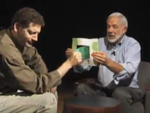 This is the last post for 2012, so it's time for look back at the highlights of Grey Matters' posts over the past year.
This is the last post for 2012, so it's time for look back at the highlights of Grey Matters' posts over the past year.
January
The biggest event for Grey Matters in January, of course, was the release of Day One, my simplified day of the week for any date feat taught via ebook, software, and videos. In honor of the new year, I'm reducing it from $9.99 to $6.99 through January 7th!Even before that, the year started off with the Sliding Calendar Puzzle and a blog post introducing it. When Scam School covered the classic 8 queens puzzle, I posted a working online version of the puzzle so you could try it out for yourself!
We also celebrated the 25th anniversary of Square One TV.
February
February's most popular post was Around The World in 7.2°, about Eratosthenes' estimation of the circumference of the Earth.Sadly, we lost noted mathematician Nicolaas Govert de Bruijn in February. In his honor, I took a look at some of his discoveries, especially concerning how their use in performance magic and recreational mathematics.
March
Grey Matters celebrated its 7th anniversary this month. I can't believe we're already getting close to #8!Appropriately for the month containing Pi Day, fun with geometry was a minor theme, featuring posts about fractal dimensions and tessellations.
Our favorite game Nim made another appearance, this time played with pizza so as to insure you get more than the other person.
April
National Poetry Month kicked off with a look at memorizing poetry.Nim showed up once more, in the guise of an all-Xs version of tic-tac-toe called Notakto.
I also began a series of posts that closely examined various ways to determine someone's age. The approaches included algebraic methods, judging by appearances, and a combination of those two approaches.
May
April and May seemed to blend into a single month on Grey Matters. The age-guessing posts concluded with a method using a person's birthday and the day of the week on which they were born.I expanded on the introduction of Notakto by posting 2 new tutorials, How to Play and Win Notakto and How To Play and Win Notakto: 3+ Boards.
Also in the spirit of revisiting past topics, I released a new free Knight's Tour web app, looked at Wythoff's Nim, and included some new touches for Day One.
June
It seems that June was a very eclectic month, beginning with a post on memorizing playing cards, and memorizing USA-related facts.There was plenty of math that month, including free mathematical magic, the 100th anniversary of Alan Turing's birth. More unusual topics included calendar history and the arguments for Pi, Tau, and Eta!
July
A card trick based on de Bruijn's work started July's posts. Other fun feats included the estimation of square roots (including some tips and tricks) and techniques for division with decimal accuracy.It was also a good month for videos about math and memory techniques.
August
No, Nim wasn't ignored in the latter half of the year. Nim updates were featured early on in this month.August seemed determined to end on a down note, first with news about major math mistakes, followed by the sad news of Neil Armstrong's death.
September
Nim was very prominent this month, including a post on playing free Nim games on iOS devices, and how to win a version called Abacan (part 1, part 2).“Card” Colm Mulcahy and a few others showed off some of their mental prowess in performances, and the Age Cards trick was re-examined to round out the month.
October
Inspired by my look at September's Age Cards post, Brian O'Neill shared his incredible game show version with Grey Matters readers. We also discovered a few other ways to play with the power of 2.Overall, October seemed to be a fun month, especially since we had 10/11/12, a remembrance of Martin Gardner, and we even re-examined the Fibonacci addition trick!
November
Probability moved into the spotlight in November, with posts about using Wolfram|Alpha to visualize odds, a 2-card bet, and Bayes' theorem.November drew to a close with some fun and unusual posts, including how to create your own personal equation and the Desmos Graphing Calculator.
December
This brings us to the final month of 2012, in which math magic took hold. The Desmos Calculator helped us examine some surprising aspects of the integer lattice in part 1 and part 2 of this mini-series.The theme continued through posts about free math magic books, an improvement on the Wolfram|Alpha factorial trick, Robert Neale's imaginative routines, and one last visit from Nim when Scam School taught Dice Nim.
I hope you take the time to look back through the archives, and find a few new favorites to enjoy. In our next post, it will be time to start looking forward to 2013!


 Congratulations to
Congratulations to 


 I was recently playing around with the
I was recently playing around with the 



